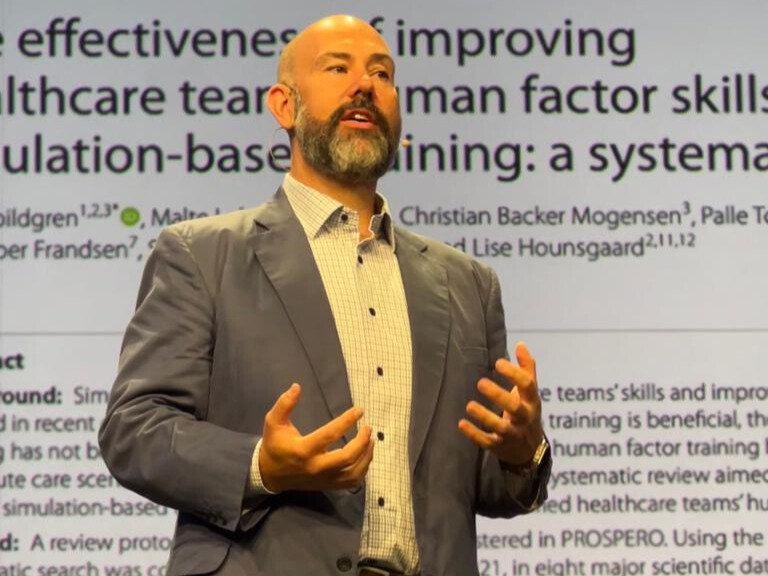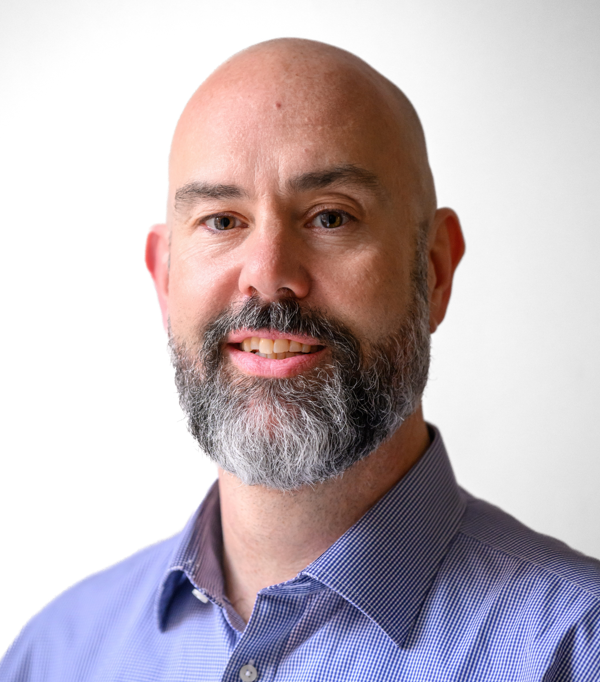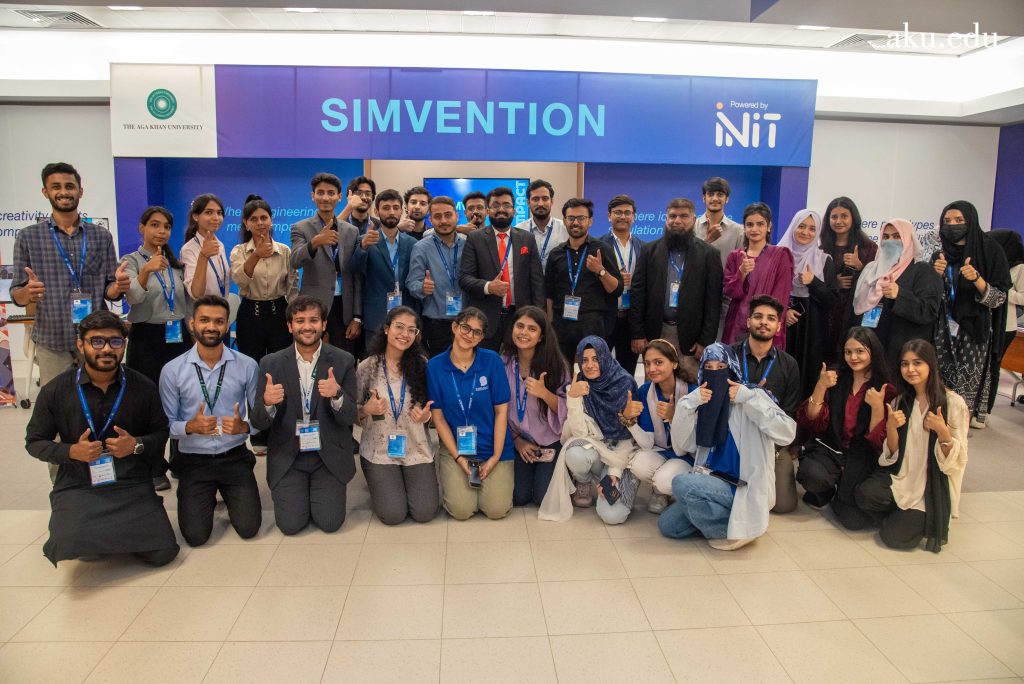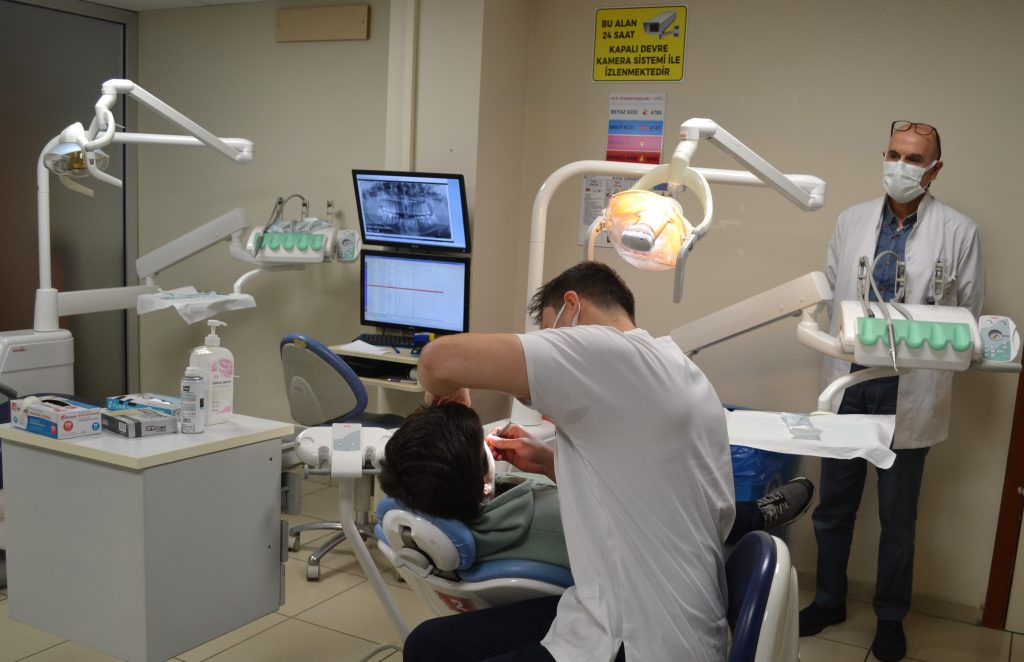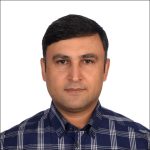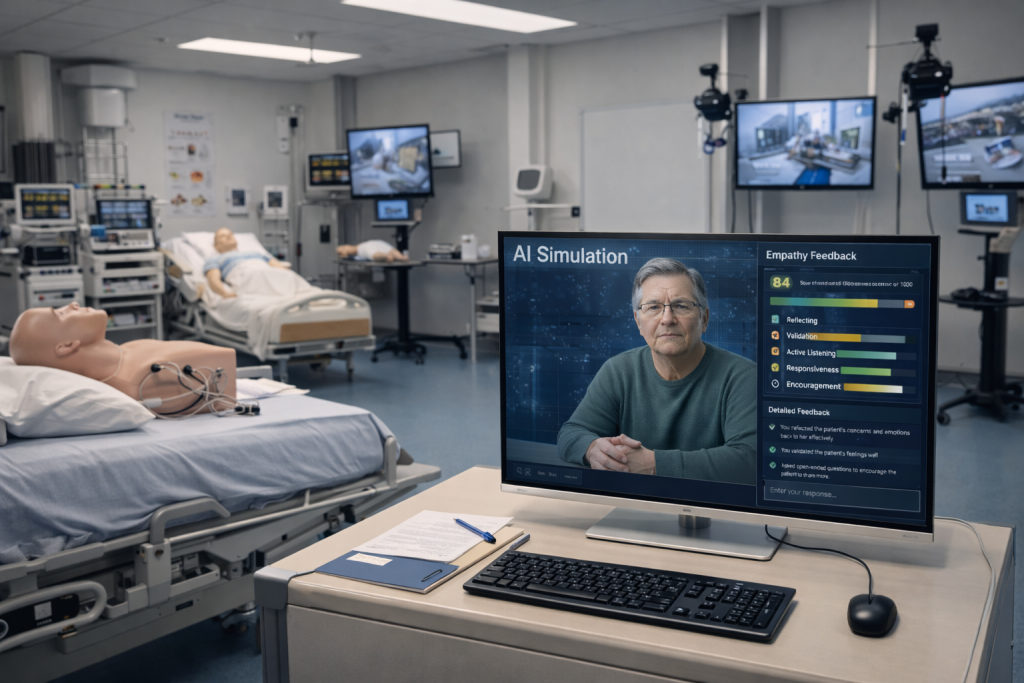Gabriel Reedy, the Editor-in-Chief of Advances in Simulation, shares his unique journey from aspiring pilot to leading academic and editor, reveals the day-to-day challenges of balancing editorial duties with an academic career, and discusses the future of healthcare simulation. Amongst his priorities, innovation and global collaborations to enhance training and patient care outcomes.
DOI: https://doi.org/10.69079/simzine.H24.n14.00017
At the intersection of healthcare education and simulation we found Gabriel Reedy, Editor-in-Chief of Advances in Simulation and Professor of Clinical Education at King’s College London. A Chartered Psychologist, Reedy blends his expertise in psychology with a passion for improving how healthcare teams learn and collaborate in simulated environments. Since taking the lead at the outset of the pandemic in 2020, he has steered the journal through significant global challenges.
In our conversation, Professor Reedy shares his journey from aspiring airline pilot to leading a major scientific journal in simulation, reflects on the challenges of balancing editorial duties with an academic career, and discusses the journal’s mission to push the boundaries of simulation science and practice. This interview offers a behind-the-scenes look at the journal’s impact on global healthcare education and Professor Reedy’s vision for its future.
Gabriel Reedy
Hi Gabe, thank you for eagerly joining us for this brief interview. We would like to present a behind-the-scenes look at the journal you edit and provide insights into the editor-in-chief’s perspective. Being EiC of a scientific journal is not an easy task. When did you join the journal, and what is your typical day as an editor-in-chief?
I joined the journal as an editorial board member in 2016, back when the journal was launched, working with Professor Debra Nestel, the founding editor-in-chief and my mentor. I stepped into the Editor-in-Chief role at the start of 2020, just a few weeks before the pandemic began. Like all of us who work in editorial roles at academic journals, my role as editor-in-chief is in addition to my full-time job as an academic! I am a professor at King’s College London, in the UK, where I do research in simulation and health professions education, and I run a master’s programme for healthcare professionals. So, my day is quite varied and never the same! It’s almost always, though, a combination of the things I love to do: reading, writing, designing and planning and doing research, teaching, facilitating—and now more and more, supporting and leading teams of colleagues who are doing those things.
Did you always want to be editor-in-chief of a scientific journal or did it just happen by chance?
Well, maybe not always! This role isn’t something that I dreamt about as a child, but that’s probably because I didn’t know it existed. (I actually wanted to be an airline pilot from about age 11, the first time I was on an airplane. It’s still on my list!) My undergraduate degree was in English, and I have been doing academic writing and reading since high school. From there I went into the technology industry as a writer and trainer, helping to make difficult technical concepts more understandable. As I became an academic, I knew that I wanted scholarly publishing to be a big part of my work. I have always enjoyed helping people develop their academic writing—it’s a part of my work that I have always found very fulfilling. And that’s a big part of what we do as editors!
What is the most difficult part of your job? And the most frustrating?
I think the most difficult part of my job has to be sending out those letters with the decision of “reject” on them. No one likes to be told that their work isn’t suitable for publication, especially because publishing is such an important part of the academic and clinical roles many of us have. Every time I reject a manuscript, I remember how it feels when I have gotten that message myself (yes, even editors-in-chief have manuscripts rejected!). But I try to channel that feeling into feedback for authors that explains the decision and helps them improve their work. I think the most frustrating thing for me is that a lot of folks don’t realize that virtually everyone with editorial roles in academic journals does that work in addition to their “day jobs”. Every peer reviewer, every editor at every level, does this work because they want to make a contribution to the field of healthcare simulation. So, when authors complain about how long the review process takes, it can really frustrate me. All the peer reviewers, associate editors, and senior editors do their work as volunteers!
What is the best article you have ever read in the area of simulation, and why? I know this is not an easy question
I never answer these kinds of questions – I just don’t like the question! (I can’t even tell you what my favourite type of ice cream is!) What do we mean, best article? Best how? Most cited? Most well-written? Most impactful? But to whom? I could point to a few that have really shaped my practice. I could also point to some amazing articles that have really made me think differently, and to some manuscripts that I ask my students to read when they are learning about particular aspects of simulation. But for me, there’s no such thing as the best article I’ve ever read. I think that the scientific literature always has to be considered in context, and we build on the literature in ways that mean they both support and are improved by subsequent literature. For me, to think now about a foundational or seminal article feels like an outdated conception of how science works, and our field is way too complex and diverse for that way of thinking. The healthcare simulation community is so broad, so diverse, and covers so many specialties that the question doesn’t really work for me!
I love your answer and we’ll take inspiration from it to modify the questions for the next guest of this space. Can you describe Advances in Simulation (AiS) in a few words? We would like to hear how its EiC sees it.
My approach as the editor-in-chief of AiS is that I seek for us to really live the mission and values represented by the title of the journal. We want to help to push the boundaries of the field, to help us all in the community do new and interesting things with simulation science and practice. We want to push ourselves to think in new ways, to think carefully and critically about how and why we do what we do. We want to learn and be inspired by ideas from across disciplines and fields. And we want all of that to help us improve how we train our colleagues, to take better care of patients and clients and each other, and to make health and social care better. I think the other thing we want to do, and I mean all of us on the editorial team, is that we want to help develop scholars and researchers and writers in the field—to help make them better researchers and writers. Because when we help each other learn and grow and develop, we make the research better, and we advance the field!
What sort of reach do you think Advances in Simulation has in the simulation field?
I described healthcare simulation to a colleague recently as a field that has a foot in quite different traditions. Firstly, of course, there’s an academic component to our field. Many of us are in traditional academic roles and so there’s that drive and push to think about scholarly publishing and to contribute to the field in that way. And even in that academic component we have very different disciplinary backgrounds – education, psychology, humanities, biosciences, engineering, healthcare improvement, and of course all our clinical academic specialties, among so many others. But there’s also the practitioner side of our community—the folks who are doing simulation on a weekly basis in clinical and care settings around the world, using simulation to do things that make care better and safer. Many of us straddle these worlds. And I think this is the great thing about Advances in Simulation: it serves the entire field of healthcare simulation. We aim to bring the highest quality simulation science to everyone in the field, regardless of whether you’re at a university or working in a community clinic. Last year, almost half a million Advances in Simulation articles were downloaded, and I’m really proud of that! If we were only available in university libraries, that wouldn’t have happened. But we are open access, so that really lets us reach across that broad audience!
Advances in Simulation is the official journal of the Society for Simulation in Europe (SESAM). Would you call it then a European journal?
So even though we are the official journal of SESAM, we are very much an international journal. Our editorial team and advisory board has representation from all over the world: North and South America, Europe, Africa, Asia and Australia. The journal is co-owned by the publisher (BMC Springer Nature) and the society, and both are focused on progressing the science, no matter where that comes from. And as the Editor-in-Chief, that’s my focus too! Another interesting thing about academic publishing that folks may not know about: all the business decisions about the journal are completely separate from our editorial decisions, so what gets peer-reviewed and published is completely separate from any other decisions.
And what is your vision and hope for this next period in the life and growth of the journal?
The next couple of years are a really exciting period for us as a journal. We are about to welcome a new senior editor to our team, and we are about to launch another special collection (watch out for that announcement!). We have also been around long enough now that manuscripts we have published are being cited extensively in other journals and used around the world – and we are hopeful soon that this will mean we will get our first impact factor. That will be an exciting step for us!
What is the relationship of Advances in Simulation with social media and what kind of communication does it adopt to promote the articles?
Social media is interesting for us because at the moment, of course, the landscape is so dynamic. Twitter has been huge among academics and has really helped spread ideas far and wide, but in its current instantiation the “X” platform has become problematic and many have left for understandable reasons. For many of my colleagues, it’s unclear what’s going to emerge to fill the gap. But we still tweet a lot, both as individual editors and as the journal, to share new publications. We also share news and new publications on Linkedin. We have a fantastic partnership with Simulcast, which does a regular journal club featuring manuscripts published in Advances in Simulation and in other simulation journals. It’s fantastic and I highly recommend subscribing!
What advice would you offer to young simulationists and educators in order to get their article published in your journal?
This is one of the questions I get asked the most as an editor! I have some tips for folks in this situation. I think the starting point is to read articles from AIS, especially recent ones, and try to model your work after them. Definitely look at the article types on the website, and make sure you submit your work according to what we’re looking for in each article type. We need to see if your manuscript fits those categories and it must include what we ask for, or your manuscript won’t be published—you would be surprised how many people don’t check that out! Finally, reporting guidelines are your friend. As I often say, remember they are guidelines, not tramlines – don’t be bound by everything listed in them, but use them to help keep yourself honest and rigorous in both conducting and reporting your research. And finally, make sure you build a strong case for why your manuscript makes a contribution to science. Don’t assume that because this is the “first study of its kind” that it will automatically be published!
How do you select your reviewers? And what advice do you have for early-career scientists interested in becoming a journal reviewers?
Reviewing is so important to the entire academic publishing endeavor. Without peer review, the peer-reviewed scientific literature would not exist! So please, please, volunteer to review. We select reviewers based on a number of factors. Perhaps primarily, we look for colleagues we know are doing research in the area, and who have also published in the specific area of simulation we are looking to review. We use our networks—people we meet at meetings, people we see writing and publishing in the field, as a starting point. And we ask everyone to recommend their colleagues who we may not know so well, who are researchers starting out in the field, so they can get experience in the process. The best reviews help authors think a bit differently about their work and hold the work up to scrutiny. So rather than picking apart the text and line-by-line copy editing, they point out things the authors may not have considered; remind authors of other literature that they may not have cited; point out potential problems or concerns with the research process; or highlight connections between the work and other research or practice. If you think of reviews in this way, editors will really appreciate you – and it’ll help you learn a lot yourself about how to design your own research and get your own work published!
What do you think are the biggest challenges faced by editors in the simulation and education field today?
I think that without a doubt the biggest challenge we all face now is that the expectations on us are increasing dramatically and none of us have the time we used to have. I think that’s even more true since COVID-19 completely scrambled our personal and professional lives! We are all working so hard on our “day jobs” – whether that is clinical or academic or in simulation practice—we have to work so hard to keep things running in the various services we are associated with. That makes it so hard to do innovative work, be it research or innovative practice, and also makes it so hard to engage in academic publishing, either as a reviewer or editor. For us, it means we really struggle to find reviewers, and it’s because people are so stretched for time. We can’t keep publishing science unless people are doing simulation research and innovation, peer reviewing other manuscripts, and serving as editors for journals!
There is increasing attention to the issue of Diversity, Equity and Inclusion (DEI). What role do DEI strategies play at the journal you lead?
This is an issue that’s so important to us as a field, and is to me personally as well. There is no doubt that the academic world has historically been the preserve of a very few, and there has been no diversity in that world. I think as we start to redress that situation and achieve some balance, we have a chance to make sure that differences of perspective help us to push our thinking and advance the field. Representation is important in itself; but what’s also important is that diversity makes us more thoughtful, more reflective, more insightful, more critical and therefore more productive and adventurous as a field. We are currently accepting submissions for our special collection on Equity, Diversity, Accessibility, and Inclusivity in AiS (https://www.biomedcentral.com/collections/EDAI), and we already have some fantastic contributions that are helping all of us to think differently! We need, and want, more of that.
Do you have any advice for those who aspire to one day become editor-in-chief of a scientific journal?
I would say that my best advice is to get involved as early as possible in the academic publishing process. Read as much as you can in the academic literature. Work with colleagues to participate in collaborative research and writing projects. Volunteer as a reviewer, and make it known that you are interested in learning more about the process. Ask for feedback on your reviews, tell your editor you want to become an associate editor in time. It’s a great privilege—I’m so lucky to be the Editor-in-Chief of Advances in Simulation.
Thank you very much, Gabe, for this talk. Really inspiring! And on behalf of all our readers, we thank you for sharing your ideas and perspectives.
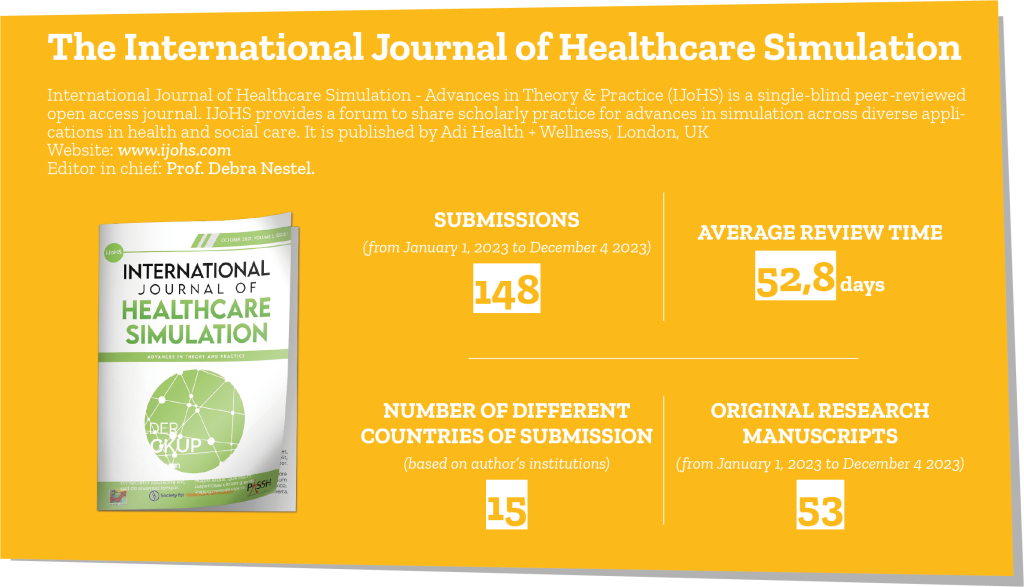
READ ALSO



